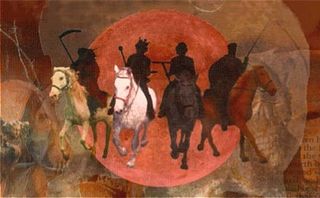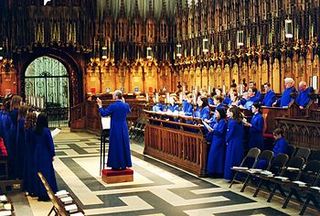I’d like to thank a Register reader who recently alerted me to a recent USA Today column by Amy Sullivan, who—according to her blurb—“is a contributing writer at Time and author of The Party Faithful: How and Why Democrats Are Closing the God Gap.”
If the Democrats are closing the “God gap,” it isn’t because of the level of thinking displayed in her column, which is titled:
Let’s put ‘Christ’-mas in its place
Titles are often chosen by editors rather than authors, so this may not be her fault. But right now we’re only bouncing on the end of the diving board, and we’re about to plunge into the 12-foot end of the pool.
If it’s December, then it must be time to choose sides in the Christmas wars. One camp worries that the celebration of Christ’s birth has become too commercial and frantic. Its goal is a simple Christmas season, stripped of consumption and flashing lights and endless holiday parties. The other camp thinks the problem is that our December festivities are practically religiously neutral. They want shoppers to encounter more nativity scenes and fewer “happy holidays” banners.
I am at a loss to explain her perception of these two “sides.” The people who think Christmas is “too commercial” are usually the very same people who think that the “religiously neutral,” “happy holidays” issue is a big part of the problem (i.e., the commercialization leads to a de-emphasis on the religious nature of the holiday in order to sell more).
By seeing this one camp as two camps, the author is already off to a schizophrenic start. She’s imagining a single side riven against itself, when in fact she’s talking about the same side.
That doesn’t stop her from feeling torn herself, though.
Every year I’m torn. I like baking Christmas cookies. I enjoy the chance to dress up in party clothes and raise a glass with friends and colleagues. I like the excuse to give gifts to those whose lives are intertwined with mine. But as a Christian who wants to focus on the spiritual rhythms of Advent and truly commemorate God’s gift of his son to the world, I find that the Christmas season gets in the way.
We can agree that the pre-celebration of Christmas tends to step on the proper celebration of Advent.
So instead of engaging in a battle to reclaim Christmas, I propose an alternative. Let’s take Christ out of Christmas.
JAW. HITS. FLOOR.
Cutting bait . . . on Christmas? Why on earth would you do that???
The battle for the soul of Christmas ended a long time ago, and cultural forces won. That’s clear when Christmas trees fill homes and apartments in Japan, a country where 2% of the population is Christian.
This makes no sense at all.
What does the ordinary home in non-Christian Japan have to do with the “soul of Christmas” and its potential improvement in countries with a Christian heritage?
Couldn’t one view the celebration of Christmas even by non-Christians a “preparation for the gospel” (as the early Christian writer Eusebius of Caesarea would put it)—a preparation that Christians can build on, inviting non-Christians to a deeper consideration of the ultimate reason that they are celebrating?
Sullivan’s horizons are far more limited. She spends a good bit of her column pinching from what she describes as a “wonderful book, ‘Christmas: A Candid History,’ [by] Methodist minister and religious studies professor Bruce David Forbes.”
I downloaded this book, and it ain’t so wonderful. It does contain some interesting points from history, but it’s written from a faith-lite viewpoint that sharply limits its value.
Proceeding from this flawed staring point, Sullivan goes on to suggest the familiar canard about early Christians basing Christmas on pagan holidays—something for which there is no evidence (and, in fact, which there is evidence against).
At least in his book Forbes stresses how much of his theory is sheer speculation. Sullivan makes no such disclaimers.
She claims that a purely religious celebration of Christmas never existed and that it was always mixed with pagan partying. This cannot be substantiated from the historical record.
She then says:
That reality has frustrated religious communities for centuries. After the Reformation, the Puritans were appalled by the excess and non-biblical practices associated with Christmas, and launched an actual war on Christmas that culminated in the English Parliament’s 1652 decision to outlaw Christmas. In the American colonies, Puritan influence resulted in subdued observances. In fact, with few exceptions, the U.S. Congress met on Christmas Day every year until the mid-19th century.
Okay, let me get this straight. Sullivan is arguing that the battle for the soul of Christmas is irretrievably lost, and in the same breath she’s admitting that it survived a withering attack between the 1600s and the 1800s and has since become such a widespread celebration that it’s even normal in Japan?
If anything, that sounds to me like the idea of Christmas is extraordinarily resilient, and the overcommercialization of it is a recent historical phenomenon that might be no more longlasting than the Puritan attempt to suppress it was. Who knows what Christmas will be like in the year 2525—if man is still alive, if woman can survive?
When Christmas had its comeback en route to becoming the blowout holiday season we now know, it wasn’t because of religious leaders. Instead, cultural factors such as the publication in 1823 of ‘Twas the Night Before Christmas, the development of the Santa Claus figure, and the nascent social valuing of family togetherness formed our modern conception of Christmas.
So . . . maybe what we need is a new poem to rival ‘Twas the Night Before Christmas?
If one set of cultural factors has harmed the celebration of Christmas then maybe we need to work at re-evangelizing the culture, including the creation of new artistic works that better convey the Christian faith.
That’s part of that whole New Evangelization thing, right?
I’m not hearing anything that would warrant Christians abandoning Christmas. What exactly is Sullivan proposing?
[I]t’s time to stop pretending that Christmas the cultural winter celebration is about the birth of Christ. Let’s just make it official and separate the two holidays that have been intertwined for most of the past two millenniums. It’s surprisingly easy to divide up the various Christmas assets left over from such a split.
First, there’s the name. Because Christmas the cultural season is so dominant, I propose that it retain the moniker, to be officially rendered X-mas. Everyone pronounces the holiday as “Chris-muss” anyway, which sounds like we’re honoring some dude named Chris, not the son of God. And despite campaigns by social conservatives to eliminate the greeting “happy holidays,” when a store clerk wishes me a “Merry Christmas,” she generally isn’t saying that she hopes I enjoy my religious observance of Christ’s birth.
As for the religious holiday, I’m calling it Jesus Day. When I was young, my family celebrated Christmas very literally as Jesus’ birthday. My Baptist grandmother baked a birthday cake for baby Jesus, along with more traditional cookies and pies. And at church, which we attended on Christmas Day, all the kids and children’s choir alumni gathered at the front of the sanctuary to belt out the tune “Happy Birthday, Baby Jesus.”
Hmmm. Interesting suggestion, Ms. Sullivan. One practiced within your very own lifetime—on Christmas Day yet. Maybe you’d like to devote a little more thought to that one before saying we should chuck Christ out of Christmas?
I would enjoy the goodwill and merriment of X-mas without reservation if I no longer felt it was co-opting and eclipsing my religious holiday.
I would feel all kinds of reservation and be totally weirded out. What kind of Twilight Zone holiday is this?
Lighting the Advent candles and reading daily devotions would provide a quiet respite during X-mas season.
So Advent would be celebrated at the same time as the de-Christed “X-mas”?
And on Christmas morning, instead of collapsing in an exhausted and mildly resentful heap, I could begin the real celebration with a full heart.
As a society, we need a designated time of year to celebrate with one another. We need the outlet of X-mas to give us a burst of festive energy to get through the winter. And we need fudge and Santa cookies, darn it. So let’s take Christ out of Christmas and make our culturewide secular celebration official. Just give me Jesus Day when it’s all over.
The proposal is thus to take Christmas, kick Christ out of it, rename it X-mas, and then rename St. Stephen’s Day as Jesus Day?
I’m sorry, Ms. Sullivan, but I think there are better ways to work out a “mildly resentful [holiday] heap” problem. I suggest an attitude adjustment.
Certainly there are better ways than surrendering a huge piece of Christian heritage and replacing it with something with the unbearably kitschy name “Jesus Day.”
Frankly, this plan zero chance of success, but it’s embarrassing and offensive that you would even make the suggestion.
I wonder what your Baptist grandmother would think.
Incidentally, this Friday I’m devoting an installment of the Jimmy Akin Secret Information Club to the top myths about Christmas—including the idea it’s a pagan celebration disguised as a Christian one. If you haven’t yet joined the club but do so before Friday (by going to www.SecretInfoClub.com), you’ll be sure to get this installment in your email inbox.
In the meantime, what do you think of Ms. Sullivan’s proposal?
Should we chuck Christ out of Christmas?





